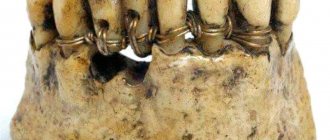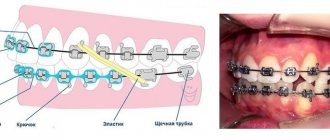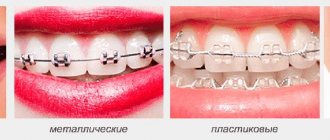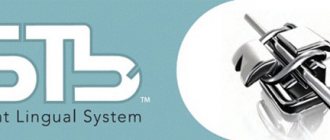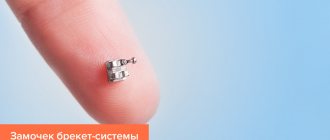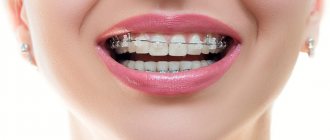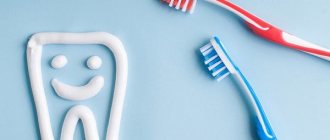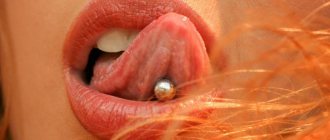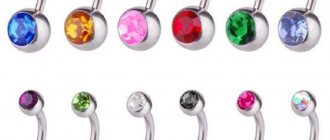If previously crooked teeth were almost a life sentence, today there are many braces systems for correcting malocclusion. The choice is so great that sometimes you get lost as to which system is best to install. Let's try to figure out which braces are the best in terms of aesthetics, efficiency, comfort, and whether there is a universal option.
What types of braces are there?
Depending on the installation method, braces can be internal (lingual) or external (vestibular). If the former are created only from metal, then the latter, in turn, differ in the material of manufacture: ceramic, metal, sapphire and plastic. It is also possible to combine designs that combine the advantages of several systems at once. Let's take a closer look at the features of each type.
- ceramic: refer to aesthetic designs, their color is practically indistinguishable from the natural shade of enamel. The system does not have sharp corners, so you can get used to them quickly enough. Disadvantages include the high cost of installation, duration of treatment and fragility,
- metal: no less popular bracket systems, which are considered the most effective and budget-friendly. Their main drawback is low aesthetics,
- plastic: the first aesthetic braces that replaced noticeable metal structures. They have similar characteristics to ceramic braces. But they differ from them in their lower price, tendency to peel off and stain, fragility and long-term bite correction,
- sapphire: occupy first place in terms of aesthetics among all vestibular brace systems. They are created from aluminum monocrystals, due to which they are able to adapt to any shade of enamel. Special production technology allows you to protect structures from staining. They have the highest price.
There is also a division of braces into ligature and self-ligating. In the first case, the plates of the structure are connected to a metal arc using special rubber bands or rings, which require periodic replacement. In the second, the ligatures are replaced by locks or latches, which independently regulate the tension of the arc and do not require regular updating.
Indications and contraindications
The brace system is indicated for malocclusion. Uneven teeth are considered the main indication, but in addition to this, doctors recommend installing braces in the following cases:
- Curled teeth. If the teeth are spaced too tightly, the oral microflora will develop faster. At the same time, with increasing load, the enamel becomes thinner and the risk of caries increases.
- Disproportional development of the jaws. If the defect is left unattended, the chewing process may be disrupted. The cause of this phenomenon may be the bad habit of chewing pencils or sucking fingers.
- Dystopia. This term means a displaced position of a tooth - its extension from a row or rotation.
- Gaps between teeth. Braces can be used to restore normal dental density. The problem may be related to tooth loss or may be genetic.
Installation of braces is not possible if the following contraindications are present: too many teeth are missing, diseases of the immune system, blood diseases, endocrine diseases, HIV, neuropsychiatric disorders have been identified.
The most inexpensive braces
Here the answer is clear - metal. These systems are considered the most cost-effective and at the same time the most effective. But it is important to remember that by choosing this option, you lose in aesthetics.
If appearance is still very important, then you can take a closer look at plastic structures. Among aesthetic ones, this is the most acceptable option. But they will take much longer to be treated than metal ones. Plus, there is a possibility of breakdown, which will lead to additional expenses.
On a note! If you want to save on treatment, it is best to ask the specialist to announce the entire amount at once. It often happens that initially the price is very reasonable, and then inspection, installation, x-rays, and removal begin to be added to it. As a result, the amount turns out to be an order of magnitude higher than what you initially expected.
At what age is it best to use braces?
Dentists agree that these aligners are ideal for children between four and ten years of age. During this period there is active growth of the jaw.
During adolescence, braces are no longer as effective. If there is a pronounced curvature of the occlusion, you will have to use, at a minimum, plates, and better yet, braces. For adults, braces are placed for minor curvatures, as well as to prevent the return of the disease after using braces.
The most aesthetic braces
Sapphire braces are considered the most aesthetically pleasing vestibular braces. They serve more as jewelry than as structures for correcting malocclusion. A great option for public people. But their cost is very high - from 120 thousand rubles for installation on both dentitions.
Another equally aesthetic option is lingual braces, which are installed on the inner surface of the teeth, on the tongue side. During a conversation they remain invisible to the interlocutor. However, their cost is also very high.
We check whether the child needs a visit to the orthodontist
There are a number of signs that indicate the need for orthodontic treatment in children:
- crowding and creeping of some teeth onto others;
- the presence of diastemas - large gaps between the teeth;
- Losing some baby teeth too early.
In addition, there are some hereditary factors that can influence the appearance of teeth in children. It has been proven that children of those people who have ever suffered from malocclusion and needed treatment will also be forced to resort to the services of an orthodontist to obtain an aesthetic and healthy smile.
Which braces are most effective?
If it is important to get the desired result in the shortest possible time, then the best choice would be self-ligating metal bracket systems with the possibility of switching to the ligature type. They are strong enough, so there is no risk of increasing the treatment period due to plate breakage. At the same time, the absence of ligatures at the initial stage makes it possible to reduce the force of pressure on the teeth; due to the smaller forces, the impact is more precise. At the final stage, you will still have to switch to the ligature type to achieve better results.
Also, the systems do not require constant adjustment, which is another advantage - you will have to visit the doctor less often. But it should be noted that non-ligature braces are much more expensive than conventional ligature braces.
Prices for braces in our clinic
The price of a braces system consists of several components:
- type of orthodontic structure
- material from which the braces are made (metal, ceramic, sapphire)
- manufacturing company
INTAN Implantation and Dentistry Centers offer an objective price/quality ratio for dental correction in St. Petersburg. Our policy is honest, low prices , which means you won’t find hidden fees or fine print in the contract.
In addition to the above factors that influence the final cost of orthodontic treatment, the price formation is influenced by the initial condition of the patient’s oral cavity, the need for preliminary preparation, and the frequency of correction during treatment.
You can consult a dentist about the details of installing a braces system, who will offer several options that are suitable specifically for your situation. To avoid problems, it is better to make the final choice together with your doctor.
The most comfortable braces
Those patients for whom comfort is paramount during treatment should pay attention to ceramic, plastic and sapphire designs. These systems are distinguished not only by their aesthetics, but also by their smoothness, small size, and ease of wearing. They do not cause allergic reactions, so they are suitable for patients with hypersensitivity. Unlike metal braces, the adaptation period passes quite quickly, the plates practically do not rub the mucous membrane.
Some brands also produce mini-systems that are several times smaller than regular ones. Due to their small size, they are practically not felt on the teeth and do not cause discomfort during treatment. As a rule, we are talking about metal structures, which, due to the strength of the material, even with a decrease in the size of the plates, make it possible to maintain the high quality of fasteners.
Types of braces by material
The arch in the bracket system is a wire made of aluminum, silver or steel. But the type of design characterizes the material used to make the plates. The most popular braces are:
- Plastic
. The most fragile and short-lived in comparison with analogues. Indicated for correcting minor defects when treatment should take no more than two months. They cannot cope with severe malocclusion diseases. They require careful handling and cleaning, as excessive mechanical stress can lead to scratches, damage and complete breakdown. Most often used for orthodontic treatment of children. Not recommended for people involved in active sports. The plates of plastic brace systems are available in several options - white, transparent and colored (with a choice of colors). When cleaning, you must use only soft brushes and non-abrasive pastes. To avoid bad breath, it is recommended to use mouthwash after every meal. The choice of care products should be coordinated with the orthodontist. - Metal
. The most common braces. Such systems cope with even the most complex malocclusion pathologies. The use of these orthodontic devices guarantees the shortest possible time to achieve the desired effect. They are highly durable and do not stain when consuming food and drinks. The plaque can be easily removed from them. Since these braces are made of medical steel, allergies are rare. - Ceramic
. Modern dentistry can offer the production of ceramic braces to match the tooth enamel. If, at the same time, the arc is painted white, the structure will be noticeable only upon close examination. This option is ideal for those who plan to hide the fact of orthodontic treatment. Plaque can be easily removed from this type of braces. Due to the fact that ceramic models have a lower coefficient of friction (compared to metal ones), they last longer. Since ceramics is not the most durable material, bracket systems made from it are not prescribed in cases of complex occlusion pathologies. - Sapphire
. An ideal option for those who would like to effectively hide the use of braces. But, the transparency of the plates requires great care when cleaning, since any stuck food particles will be visible. To the traditional methods of oral care, it is worth adding treatment of teeth with an irrigator. They are used to eliminate mild and moderate pathologies, since artificial crystals are more fragile than metal or ceramics, and therefore cannot withstand heavy loads. - Titanium
. They can be classified as a type of metal braces. Compared to the steel structures described above, titanium structures are even more durable and lightweight. Having high biocompatibility (there is no nickel in the composition, as in metal analogues), titanium braces do not cause allergies and are indicated even for those patients who have problems with the gastrointestinal tract. - Combined
. They are a combination of several types of braces. Combining several materials in one design makes it possible to achieve a more aesthetically pleasing appearance of the systems, which is especially important for people who are concerned about their smile while wearing braces. Most often, more expensive ceramic/sapphire plates are placed in the smile area, and metal plates are placed on the chewing teeth. Although, the combinations can be very diverse.
In the process of choosing braces material, the orthodontist will definitely find out if there are any contraindications and, based on the collected anamnesis, will understand which design is optimally indicated in your case.
| Advantages | Flaws |
| Plastic | |
|
|
| Metal | |
|
|
| Ceramic | |
|
|
| Sapphire | |
|
|
| Titanium | |
|
|
| Combined | |
| They have advantages and disadvantages of those materials that are combined in the orthodontic apparatus | |
Which braces are easiest to care for?
Each type of braces requires careful care and caution when worn. Metal brace systems are less demanding in this regard, as they allow you to practically limit yourself in food. They are not painted, have high strength, and are resistant to temperature changes.
It is also quite easy to care for self-ligating systems, since they do not have ligatures in which food becomes clogged and plaque accumulates.
Which bracket system is better: self-ligating and ligature designs
Bite correction systems differ in the method of fixing the archwire in the bracket groove. The classic option is ligature constructions. The arch is tightly fixed to each bracket with elastic or metal ligatures. The design is suitable for the treatment of anomalies of varying complexity. It is necessary to visit a doctor once a month to replace the archwires.
Orthos ligature braces
Self-ligating structures do not have elastic and wire elements fixing the arch in the bracket groove. Friction in the system is minimal. Arc sliding occurs under the influence of weak forces. Non-ligation structures do not require monthly visits to the doctor: it is enough to carry out activation once every 2-3 months.
self-ligating Damon Q2
According to the results of research by Khalid S. Hassan from the University of Ed-Dammam, Saudi Arabia, it was revealed that the microbial flora in the oral cavity when using self-ligating systems was lower than when treated with ligature structures. 22 patients participated in the study. In each case, two ligation systems were fixed in the oral cavity: ligature structures were installed on one side, and devices without ligatures were installed on the other. The use of ligature systems caused microbial colonization and increased the activity of the enzyme aspartate aminotransferase. Treatment with self-ligating braces turned out to be a more preferable method of occlusion correction from the point of view of preventing disorders in periodontal tissues.
What are the best braces for a child? Each clinical case requires an individual approach from the orthodontist. Only a doctor, based on the diagnosis and structural features of the young patient’s dental system, offers the most suitable options. As a rule, the issue of aesthetic preferences in children is not as acute as in adults. Teenagers often choose ligature or non-ligature metal systems. A wide variety of elastic ligatures allows you to express the individuality or mood of the child, and the visibility of the design has ceased to be a criterion for choosing a system. Teenagers wear devices with multi-colored elastic elements and do not experience discomfort.
non-ligature Damon 3MX metal
When treating children with braces, it is important for parents to pay attention to teaching the child oral hygiene and motivate them to follow all the orthodontist’s recommendations. Some teenagers, despite the instructions of their parents, pay insufficient attention to hygiene procedures. In this case, installing a non-ligature brace system for a child will be a more preferable option.
The best braces: which systems to choose
Each brace system has its own characteristics and making a clear choice is quite difficult. The patient should first of all listen to the advice of the orthodontist - an experienced specialist will recommend a specific model that is suitable for your case, taking into account the position of the teeth and the condition of the bite. Be sure to take into account your own requirements for the appearance and comfort of the device. The financial component should also play an important role.
When choosing, you should also consider the brand of braces, since products from different companies may have different quality. Don't rely only on reviews from the Internet. This is an important factor, but not decisive.
Other varieties
One of the solutions to the problem of correcting malocclusion in children is the invention of colored or shaped “braces.” In fact, such systems have colored ligatures, and not the braces themselves, and in general an interesting effect is created.
Children and teenagers are often embarrassed to wear classic corrective braces, and a colored or shaped version can greatly simplify this procedure. As a result, such “braces” become a detail of the image, emphasizing individuality. In addition, the period of adaptation to wearing the structure, purely psychologically, passes in an easier form.
Curly braces
There is no point in talking about curly braces as a special type: these are ordinary systems equipped with ligatures of a unique shape. Children and teenagers prefer ligatures in the shape of stars or hearts. For parents, this often becomes the only effective way to involve the child in the treatment process, especially since sometimes it stretches over several months or longer periods.
Colored "braces"
Colored ligatures of colored “bracket systems” do not have any design features; they are designed to perform the same functions as ordinary conventional braces. The only additional role of these structures is to eliminate psychological barriers that prevent you from deciding to correct bite defects.
The color of the corrective system changes either through the use of ligatures of different colors, or plastic ligatures of the desired shade are placed. This is especially true for children, teenagers and adults who want to emphasize their creativity.
